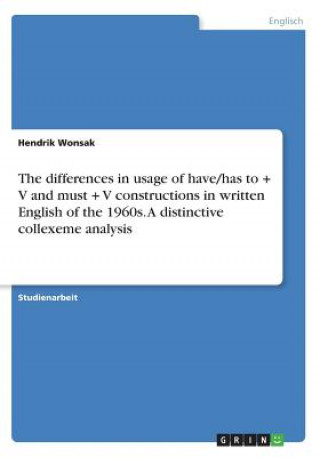
Kód: 16106277
The differences in usage of have/has to + V and must + V constructions in written English of the 1960s. A distinctive collexeme analysis
Autor Hendrik Wonsak
Studienarbeit aus dem Jahr 2016 im Fachbereich Anglistik - Linguistik, Note: 2,3, Universität Hamburg, Sprache: Deutsch, Abstract: Do I have to write this term paper or must I? Is there even a semantic difference between the two c ... celý popis
- Jazyk:
 Nemčina
Nemčina - Väzba: Brožovaná
- Počet strán: 20
Nakladateľ: Grin Publishing, 2017
- Viac informácií o knihe

Mohlo by sa vám tiež páčiť
Darčekový poukaz: Radosť zaručená
- Darujte poukaz v ľubovoľnej hodnote, a my sa postaráme o zvyšok.
- Poukaz sa vzťahuje na všetky produkty v našej ponuke.
- Elektronický poukaz si vytlačíte z e-mailu a môžete ho ihneď darovať.
- Platnosť poukazu je 12 mesiacov od dátumu vystavenia.
Viac informácií o knihe The differences in usage of have/has to + V and must + V constructions in written English of the 1960s. A distinctive collexeme analysis
Nákupom získate 109 bodov
 Anotácia knihy
Anotácia knihy
Studienarbeit aus dem Jahr 2016 im Fachbereich Anglistik - Linguistik, Note: 2,3, Universität Hamburg, Sprache: Deutsch, Abstract: Do I have to write this term paper or must I? Is there even a semantic difference between the two constructions have/has to + V and must + V? Epistemically, there is little diference between the two constructions, but a deontic approach shows that the construction must + V obliges the subject of the sentence to do something, while the construction have/has to + V does not play a strong deontic role. Nevertheless, native speakers of the English language use both constructions more or less indiscriminately. This term paper rejects the common approach that the two constructions are semantically identical, since certain verbs are more likely to occur in the have/has to + V-construction, than in the must + V-construction. According to Gries and Stefanowitsch, traditional linguistic studies view the lexicon and the grammar of a language as two completely diferent phenomena. In their cited publication, they state that "various expression types that fall somewhere in between lexicon and grammar have been recognized but largely ignored by mainstream syntactic theories" (Gries & Stefanowitsch, 2003, 209). Over the past decades, however, a variety of linguists, such as Lewis Hunston, Sinclair, Gries and Stefanowitsch themselves, have published a variety of theories, which approach a diferent view towards the connections between grammar and lexicon. These theories assume that "grammar and lexicon are not fundamentally diferent, and that the long-ignored multi-word expressions serve as an important link between them" (Gries & Stefanowitsch, 2003, 210). Following these theories, pairs of semantically more-or-less corresponding expressions and constructions, as the ones shown in (1) to (3), have occupied the attention of linguists all over the world (Gries & Stefanowitsch, 2004, 97): (1) Peter gave Mary the ball / Peter gave the ball to Mary (2) Frank is going to be happy / Frank will be happy (3) Peter must give Mary the ball / Peter has to give Mary the ball
 Parametre knihy
Parametre knihy
Zaradenie knihy Knihy po nemecky Geisteswissenschaften, Kunst, Musik Sprach- und Literaturwissenschaft Allgemeine und Vergleichende Sprachwissenschaft
44.37 €
- Celý názov: The differences in usage of have/has to + V and must + V constructions in written English of the 1960s. A distinctive collexeme analysis
- Autor: Hendrik Wonsak
- Jazyk:
 Nemčina
Nemčina - Väzba: Brožovaná
- Počet strán: 20
- EAN: 9783668402515
- ISBN: 3668402515
- ID: 16106277
- Nakladateľ: Grin Publishing
- Hmotnosť: 44 g
- Rozmery: 210 × 148 × 1 mm
- Rok vydania: 2017
Obľúbené z iného súdka
-

SEOUL University Korean 1A Student's Book QR
42.41 € -

EASY KOREAN with BTS - for Basic Learners | 2-Book Set
42.41 € -

Reading CAE
27.28 € -
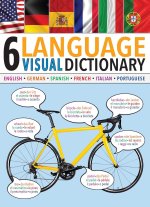
6-Language Visual Dictionary
18.73 € -13 % -
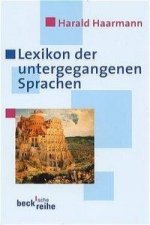
Lexikon der untergegangenen Sprachen
13.58 € -

Latin for Beginners
48.80 € -
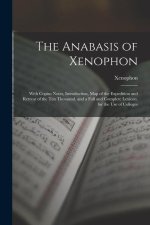
The Anabasis of Xenophon: With Copius Notes, Introduction, Map of the Expedition and Retreat of the Ten Thousand, and a Full and Complete Lexico
33.35 € -

Sejong Korean Student Book 1A - English Edition
28.82 € -

My First 500 Korean Words - Book 2
45.50 € -

Meine ersten 270 Wörter auf Schweizerdeutsch
7.30 € -4 % -
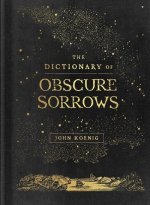
Dictionary of Obscure Sorrows
16.67 € -23 % -

Sejong Korean Work Book 1A
21.51 € -

Sejong Korean Vocabulary and Grammar 1A
11.21 € -
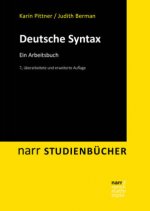
Deutsche Syntax
29.95 € -

Sejong Korean Vocabulary and Grammar 1B
11.21 € -

Ewha Korean 1-1 Workbook
21.51 € -

Arabic For Beginners Workbook
19.25 € -

Magyarul mint oroszul 1000 szó magyarázattal
26.45 € -10 % -
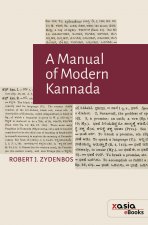
A Manual of Modern Kannada
28.72 € -9 % -
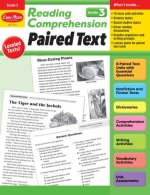
Reading Comprehension: Paired Text, Grade 3 Teacher Resource
24.50 € -7 % -
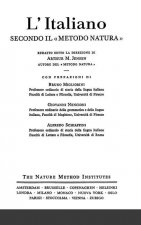
L'italiano secondo il metodo natura
86.79 € -
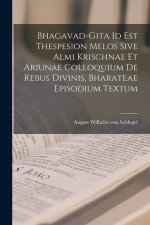
Bhagavad-gita Id Est Thespesion Melos Sive Almi Krischnae Et Ariunae Colloquium De Rebus Divinis, Bharateae Episodium Textum
26.35 € -

A New Practical and Easy Method of Learning the Russian Language
22.85 € -

One Thousand and One Nights for Elementary Egyptian Arabic Language Learners
18.63 € -
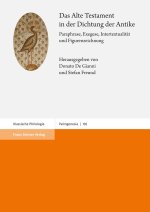
Das Alte Testament in der Dichtung der Antike
94.62 € -

Sejong Korean Student Book 1B - English Edition
28.82 € -

C1 Writing | Cambridge Masterclass with practice tests
27.69 € -

Sejong Korean Work Book 1B
21.51 € -

Sejong Korean Work Book 2A
21.51 € -
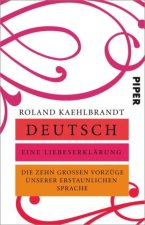
Deutsch - Eine Liebeserklärung
12.66 € -

Power of Language
23.16 € -3 % -

Sejong Korean Extension Activity Book 1A - Korean Edition
21.51 € -

Sejong Korean Student Book 2A - Korean Version
28.82 € -
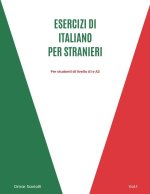
Esercizi di italiano per stranieri - Vol.1
17.49 € -

Sejong Korean Extension Activity Book 2A - Korean Edition
21.51 € -

Speed Reading
10.08 € -19 % -

Korean Made Easy - Vocabulary
41.38 € -

Sejong Korean Vocabulary and Grammar 2A
11.21 € -

Sejong Korean Work Book 3A
21.51 € -

C2 Writing | Cambridge Masterclass with practice tests
30.16 € -18 % -
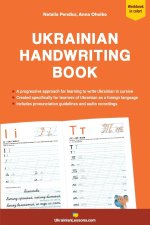
Ukrainian Handwriting Book
43.44 € -

Learn Finnish with First Finnish Reader for Beginners
27.28 € -

Writers' & Artists' Yearbook 2024
34.38 € -19 % -
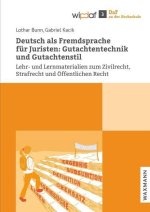
Deutsch als Fremdsprache für Juristen: Gutachtentechnik und Gutachtenstil
35.41 € -

Sejong Korean Extension Activity Book 1B - Korean Edition
21.51 € -

Sejong Korean Extension Activity Book 4A - Korean Edition
21.51 € -

Student's Introduction to English Grammar
33.35 € -4 % -

Korean Made Easy - Starter
28.82 € -
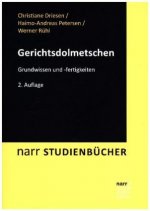
Gerichtsdolmetschen
28.92 €
Osobný odber Bratislava a 2642 dalších
Copyright ©2008-24 najlacnejsie-knihy.sk Všetky práva vyhradenéSúkromieCookies



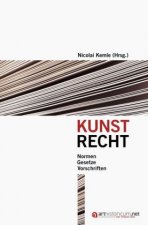




 21 miliónov titulov
21 miliónov titulov Vrátenie do mesiaca
Vrátenie do mesiaca 02/210 210 99 (8-15.30h)
02/210 210 99 (8-15.30h)